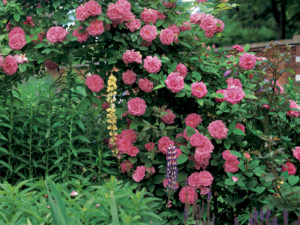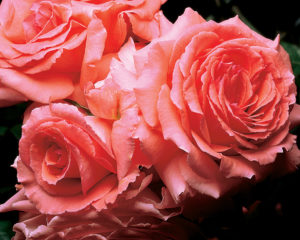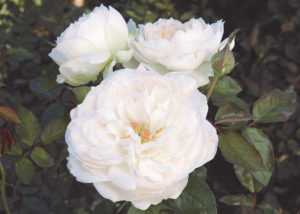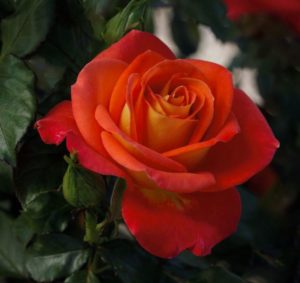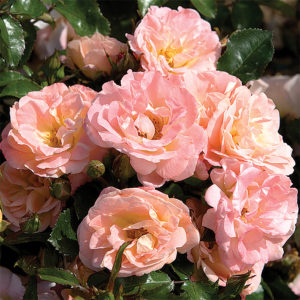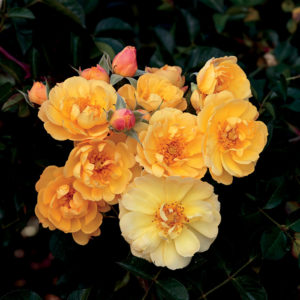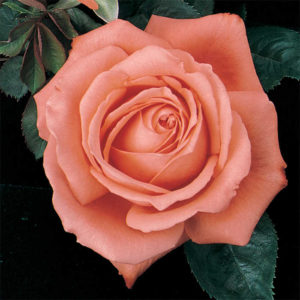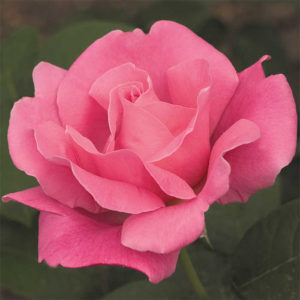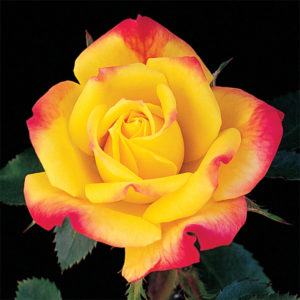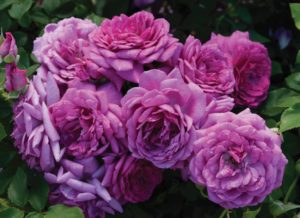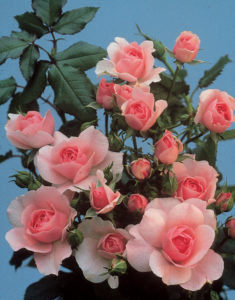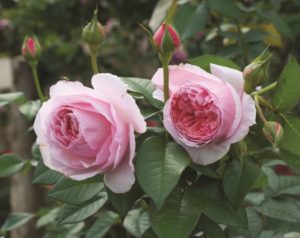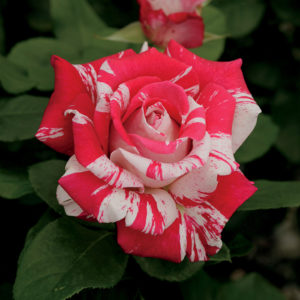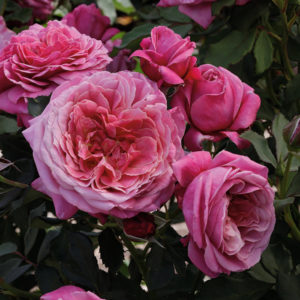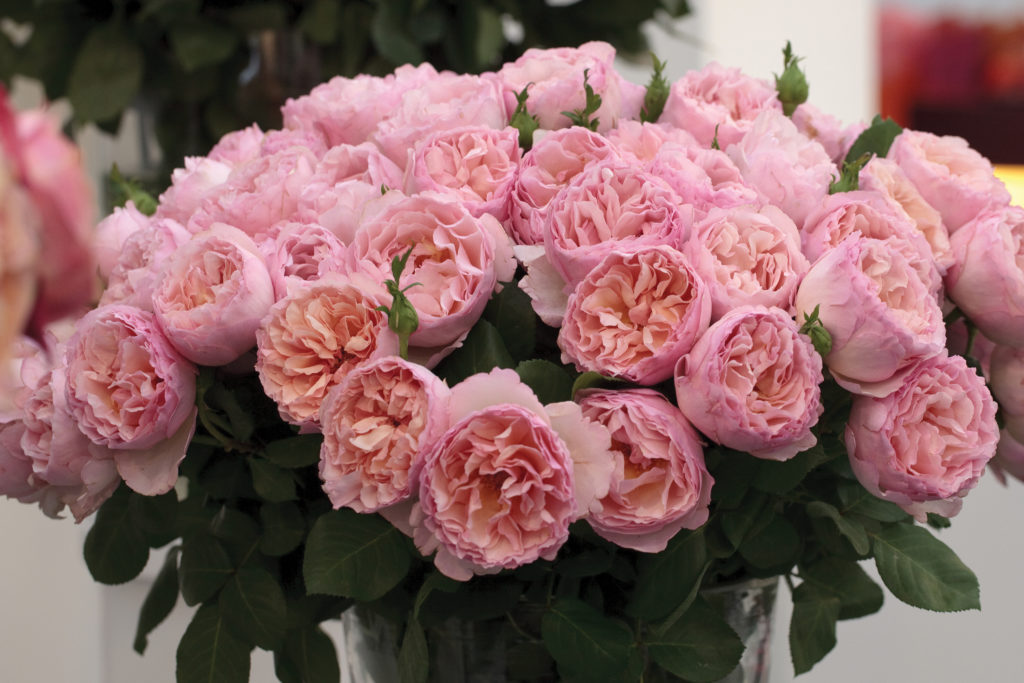
Roses are called the “Queen of Flowers” for the beauty they provide to the landscape. They need proper care to ensure that they produce the best possible display each season, but the rewards are well worth the effort. The American Rose Society classifies roses into three main groups; Species Roses (wild roses), Old Garden Roses (existing prior to 1867), and Modern Roses (varieties created after 1867, when the first man-made hybrid tea ‘La France’ was created). Within these groups of roses, home gardeners will discover very special, unique features and a plethora of growth characteristics, to make roses a wonderful option for almost any garden application.
Modern Roses are some of the most widely recognized and utilized garden roses in the world. Unlike Old Garden Roses, which typically bloom only once per season, Modern Roses can bloom repeatedly in a growing year. Most have been bred for larger blooms, longer vase life, more fragrance, and higher resistance to disease. Because the group is extensive, these Modern Roses are further classified or grouped, based on growth habit and flowering habit, into distinct categories.
Climbing Roses
Climbing Roses have long, stiff stems that can be used to cover a fence or archway. The trusses of flowers are borne primarily on the wood that grew the previous year, so the stems that grow in summer must be protected from the winter cold to have a full bloom next summer. Climbers need proper maintenance to ensure an abundance of foliage and flowers.
New 2020 Climbing Rose
The American Climbing Rose is a combination of beauty and fragrance that magnetizes the senses. Beautifully formed 4 to 5 inch double blooms of bright coral-pink are saturated with a rich, spicy fragrance that’s rare in modern climbers. This award-winner has been a favorite of rosarians for many years. Fast-growing vigorous canes reach 10 to 12 feet. Blooms on both new and old wood.
Floribunda Roses
Floribunda Roses are somewhat shorter in height and more floriferous than other roses, producing large clusters of multiple flowers that are generally smaller than Grandiflora and Hybrid Teas. The term “floribunda” refers to the abundance of flowers they produce. Floribunda roses can be mixed with other types of roses or be used independently in the landscape or perennial border to add bold color and fragrance. They are generally hardier, more carefree, and more reliable in wet weather. After a bloom cluster is spent, cutting it back will encourage a new flush of growth and more flowers.
Burst of Joy has parentage that includes both Love & Peace and Ketchup & Mustard, how can this rose bring anything but a Burst of Joy? Vivid blooms are bright orange with a yellow reverse – an eye-popping combination that is sure to knock you over. Quite long-lasting, both in a vase and on the bush, the waves of blooms are sure to bring joy wherever they are. Rounded plants are filled with glossy green leaves that exhibit good disease resistance.
Groundcover Roses
Groundcover Roses (sometimes called landscape roses) are included as some of the hardy Shrub Roses. They are low growing with a spreading habit. They are used in massed plantings and to cover banks or other areas where there are erosion problems. They are also useful to add a splash of color to a border or for an accent in a rock or perennial garden. Most groundcover roses are easy-to-grow, low-maintenance, and very disease resistant. The Knock Out, Meidiland®, and Happy Trails™ selections are all excellent examples of this popular type of rose.
Sunshine Happy Trails create a beautiful weave of gold ribbons through your landscape. Blooming in clusters, 2 to 3 inches, the yellow flowers emit a light, fruity fragrance into the air. Spreading plants grow up to 18 inches tall and up to 5 feet wide.
Hybrid Tea Roses
Hybrid Tea Roses are the most recognized and oldest class of modern roses. They typically produce single large buds, each on its own stem, opening into large flowers. Hybrid tea roses are the most common rose used as cut flowers. The buds usually come in flushes and follow the deadheading or major pruning of the plant. Hybrid tea roses often need winter protection in the most northerly climates to consistently survive cold winters, though many named selections have been developed for improved winter hardiness; such as Sub-Zero Roses bred by Dr. Walter Brownell in the 1930s and 1940s.
Perfume Delight is as fragrant as the name implies. It offers warm pink 4 to 6-inch blooms that are full and shapely, borne on long cutting stems, and endowed with a strong rose scent. Large, dark green leaves clothe the 3 to 4- foot plants.
Miniature Roses
Miniature Roses are very compact in height and usually hardier than hybrid tea roses. Cute, perky, and popular, Mini-roses make good accents for borders, beds, rock gardens, and containers. The plants are grown on their own root and usually grow to 2 feet or less in height. Miniature roses are prolific bloomers and they rebloom strongly when spent blooms are removed. Foliage is typically dark green and disease resistant. Some winter protection is recommended to ensure viability over winter, especially when they are grown in containers.
Life’s Little Pleasures has beautiful double blooms of lovely lavender-pink that fade to lavender but then hold their color to the very end. Aiming to please, this little baby has a well rounded, compact habit and sets an abundance of blooms with excellent bud and flower form.
Shrub Roses
Shrub Roses are generally hardy, low-maintenance, and are available in a number of sizes and forms. Shrub roses are mostly rebloomers, that can vary from 3 to 10 feet in height. Taller selections usually have arching branches. Their foliage is usually disease resistant and generally need minimal spraying to keep plants healthy.
The term “hardy”, when applied to a shrub rose, can be confusing, as many shrub roses do need winter protection in extremely cold winter regions. At Jung, we consider roses “hardy” when they can survive Zone 4 winters. Most shrub roses are now grown “own root” which helps them to survive winter dieback in severe cold.
Scentuous is a German-born, English-style rose with a powerful, tantalizing fragrance that’s tough to beat. It produces an abundance of light pink blooms that have a cupped and quartered form that beckons you to bury your nose amid the luscious layers of petals. Bushy plants have rich green foliage and bear their blooms in clusters throughout the season.
Tree Roses
Tree Roses are not an official class, but rather a specific form of the grafted rose plant. They have become very popular and can be found in versions of Hybrid Tea, Grandiflora, and Floribunda flowering trees, generally in sizes of 2 to 3 ft. in height.
Queen of Elegance Patio Tree Rose has Old World charm with the appeal of modern disease resistance — this rose is worthy of royal status. Her ovoid buds spiral open to reveal medium pink cupped blooms with an ‘old-time’ rose fragrance. Glossy, dark green foliage stands up well against diseases and the canes hold the long-lasting blooms at just the right height for your enjoyment.
Other Recommended Reading

- Guide to the Meaning of Rose Colors
- Popular Rose Types
- Winter Rose Care
- Rose Pests, Identification, and Solutions
At Jung Seed Co, we strive to be your go-to guide for all your gardening needs. Our YouTube channel Jung Garden Center now includes our new video series All Things Green where our experts provide gardening tips for all levels of gardeners. When you need reliable gardening advice, turn to the trusted experts at Jung.
View our new catalog online or browse our website for all of your gardening favorites. To receive info on new products, exclusive deals, and specials, be sure to sign up for our weekly email. Join our Facebook page, to discuss all things gardening!
